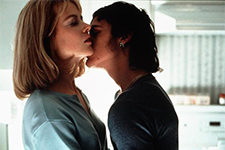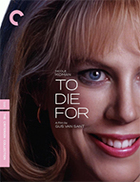To Die For (4K UHD)
|  Gus Vant Sant’s To Die For is a triumph of style over substance. Based on a novel by Joyce Maynard that was loosely inspired by the Pamela Smart case, in which a New Hampshire woman conspired with her teenage lover to murder her husband, the plotline of Van Sant’s film is old hash that combines tabloid sensationalism with film noir tropes and suburban satire. There are veins of social significance to be mined, for sure, particularly as they relate to the incestuous relationship between criminality and the media, the lure of celebrity, and the various hypocrisies that swirl around female ambition in America, but it is first and foremost an exercise in bold style, with Van Sant throwing out the traditional playbook and thereby turning what might have otherwise been a Lifetime-esque potboiler into a thrilling, darkly humorous cinematic experiment. The film basically tells you everything that will happen in the delirious opening credits sequence, which was designed by the great Pablo Ferro (who first started designing opening title sequences for Stanley Kubrick in the 1960s). It is here, cut to the swirling, carnivalesque strains of Danny Elfman’s score, that we get our first glimpses of Nicole Kidman’s blonde femme fatale Suzanne Stone amid flashes of scandalous newspaper headlines and reams of gray text that trumpet the horrors of infidelity, conspiracy, and homicide. We literally see her husband, Larry Maretto (Matt Dillon), lying dead on the carpet with a pool of blood around his head, and we see the wayward adolescents who we will come to know as Suzanne’s manipulated co-conspirators: Jimmy Emmett (Joaquin Phoenix), Russel Hines (Casey Affleck, and Lydia Mertz (Alison Folland). And, just as we are prepared for a traditional dramatization of the lurid events, the film cuts into an uncomfortable and bright close-up of Suzanne against a glaring white background, her make-up and hair perfectly done, as she begins to cheerfully relate her story. There are cuts to interviews with other characters, as well, including Jimmy, who is clearly in prison; Matt’s sister, Janice (Illeana Douglas), an ice skater who never trusted Suzanne from the start; and the parents, Joe and Angela Maretto (Dan Hedaya and Maria Tucci) and Earl and Carol Stone (Kurtwood Smith and Holland Taylor), who are discussing the case on a tabloid television show. Thus, within the first few minutes, Van Sant literally pummels us with the entire breadth of visual media, alerting us from the outset that this will not be a traditionally told sordid murder tale, even if the sordid murder tale is itself quite traditional (sad to say). The use of the interview format was borrowed largely from Maynard’s novel, but the manner in which veteran screenwriter Buck Henry (The Graduate), who hadn’t had a screenplay produced since the Goldie Hawn vehicle Protocol (1984), and Van Sant combine them with conventional dramatic scenes gives it a uniquely cinematic dimension. To Die For technically starts at the end with Suzanne’s interview (the exact nature of which is not revealed until the very end of the film), and the rest of the story skips around in time as we witness Suzanne, who is a seemingly gentle, girl-next-door type, get swept up in a romantic relationship with Larry, who tends bar at the small Italian restaurant owned by his father in an idyllic New Hampshire burg. Larry has big plans for the restaurant, but his idea of success pales in comparison to Suzanne’s, whose benign exterior masks a ravenous desire for fame that borders—no, spills over into—the pathological. Suzanne bullies her way into a job at the local television station run by Ed Grant (Wayne Knight), who capitulates to her desire to be on the airwaves by giving her the position of nightly weather girl. Suzanne, however, imagines herself to be a crusading journalist, and she convinces Ed to allow her to work on a side project documenting the local teen culture, which is how she crosses paths with Jimmy, Russel, and Lydia, all of whom are vulgar, poor, and dim-witted and therefore easy to manipulate and control. As Suzanne, Nicole Kidman graduated from award-winning film and television star in her native Australia and supporting actor in Hollywood films like Days of Thunder (1990), Billy Bathgate (1991), and Far and Away (1992), to Hollywood star in her own right. The role of Suzanne is tricky, as Kidman had to make her pathological and sympathetic at the same time; she plays the manipulator in such a way that allows us to see the gears churning inside, each glossy smile and articulate statement a testament to the character’s ongoing performance. A vicious predator, she is also a sad byproduct of America’s celebrity culture, fed by the twisted promise that happiness lies in media exposure and that, as she chirps several times, “You’re not anybody in America unless you’re on TV” (the film’s cognizance of the rapidly emerging world of reality television is eerily prophetic). Throughout the film Kidman has to shift rapidly, changing gears between Suzanne’s sunny, polished performance around others and her rotten core, which slips out at various times in increasingly ugly ways (the way she goes from pert to irritated is unsettling). She victimizes, but she is also clearly a victim herself, which is what makes Kidman’s performance so memorably provocative (the scene in which she tries to impress a loutish television personality played by George Seagal is a focused masterclass in conveying a character’s contradictory characteristics—ambitious and cunning, but also facile and dim). Similarly, future Oscar winners Joaquin Phoenix (Joker) and Casey Affleck (Manchester by the Sea) play her adolescent male dupes with a mixture of crassness and pathetic idiocy. Even more compelling, though, is Alison Folland’s Lydia, who unlike Jimmy and Russel, don’t look to Suzanne as an object of sexual desire, but rather as a missing mother figure who tragically turns out to be more Mommie Dearest than Betty Crocker. At the time, Van Sant had directed a lot of music videos by the likes of David Bowie, The Red Hot Chili Pepper, and Elton John, as well as three independently produced features that had met with mixed critical and commercial success: Drugstore Cowboy (1989), which was widely acclaimed; Even Cowgirls Get the Blues (1991), which was largely panned and failed at the box office; and My Own Private Idaho (1993), which seemed to bode well for Van Sant’s ability to mix indie aesthetics and challenging subject matter with Hollywood stars. To Die For made good on that promise, as Van Sant deftly merges mainstream thriller-melodrama with a brash, indie approach that doesn’t just work with the material, but elevates it.
Copyright © 2024 James Kendrick Thoughts? E-mail James Kendrick All images copyright © The Criterion Collection | |||||||||||||||||||||||||||||
Overall Rating: 


 (3.5)
(3.5)


